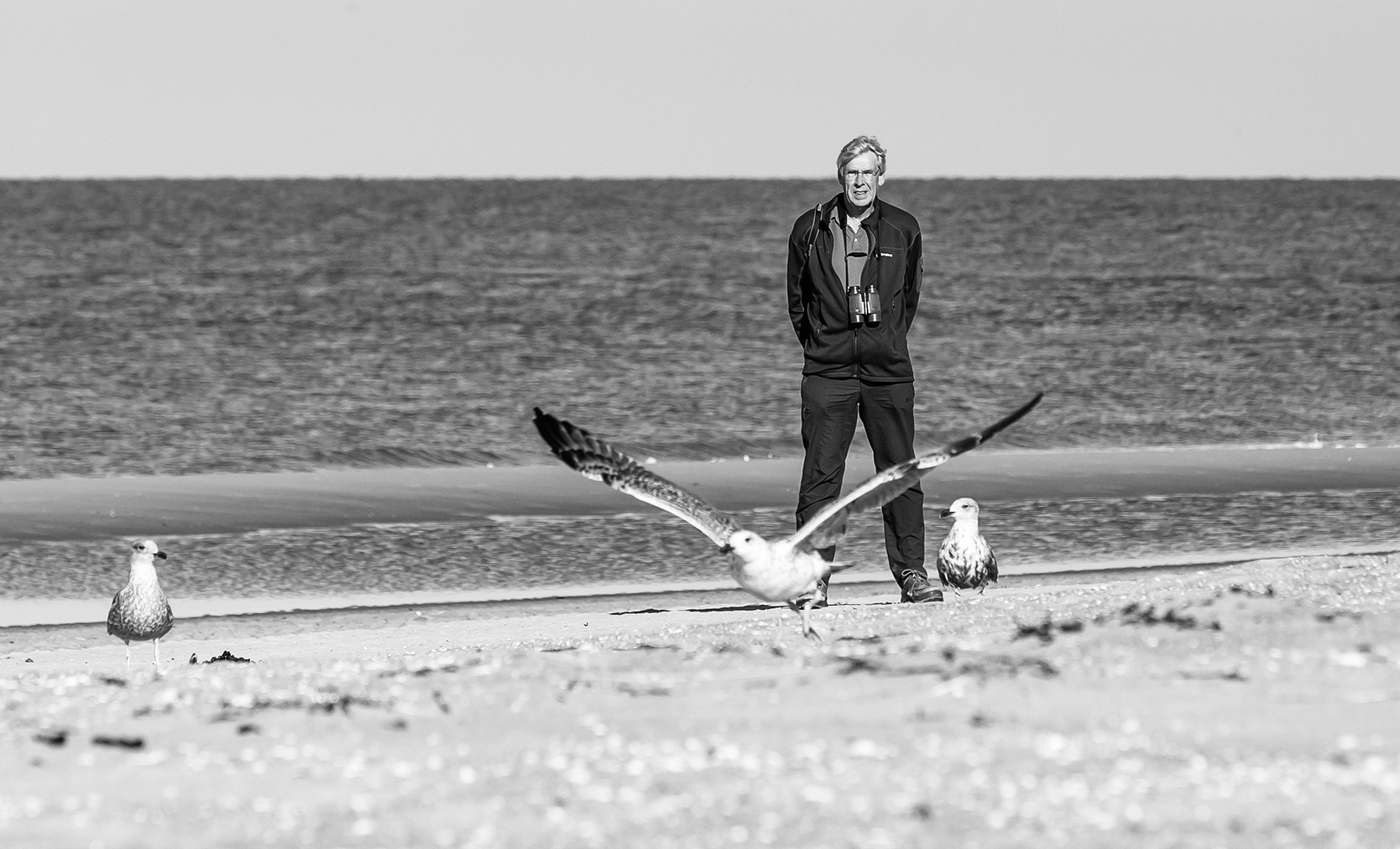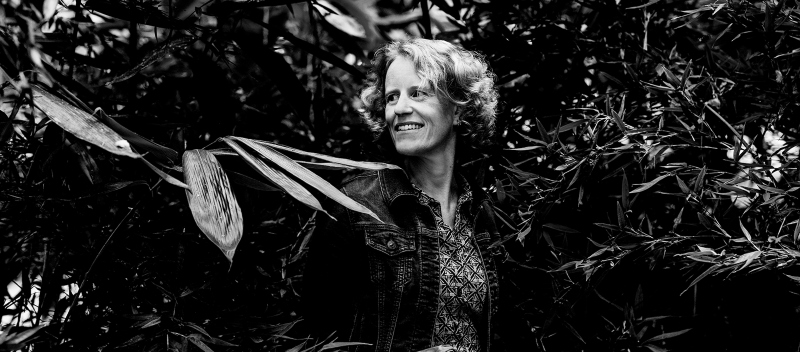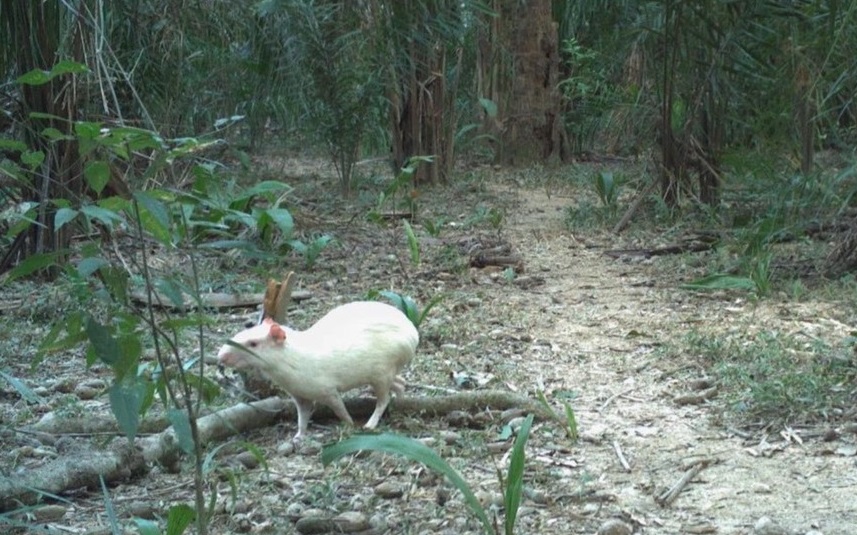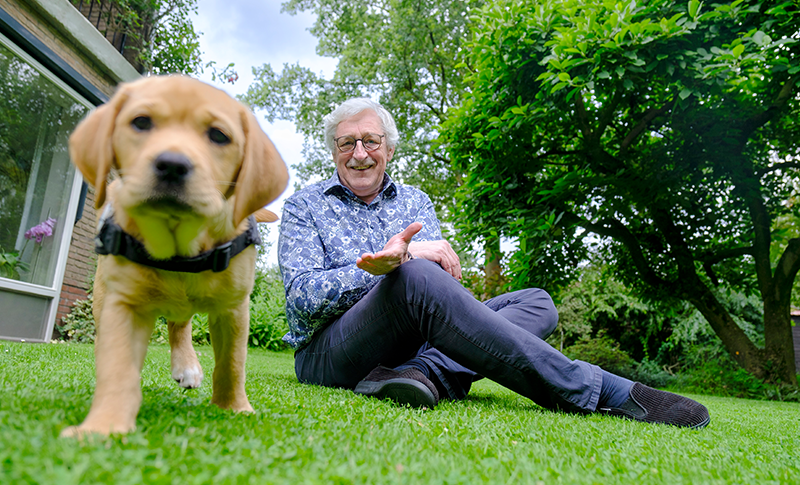Seabird pioneer and porpoise expert Mardik Leopold retires on 1 November. But on Monday morning he’ll be in the office at 8.30 as usual.
From 1 November he can concentrate entirely on his research as a guest worker. ‘Marvelous, I’m really looking forward to it. No more meetings, no more acquisition, no more keeping timesheets.’ He ‘can’t stand’ administration. ‘I’ve always avoided it. I’m a biologist. Administration is a skillset that you should leave to the professionals.’
That’s Mardik Leopold all over. To-the-point, idiosyncratic and never afraid to speak his mind. Journalists seek him out, although that also has a lot to do with his subject matter, according to Leopold. ‘I’m lucky enough to work on charismatic megafauna such as marine mammals and bird. They’re always getting in the press. The research field I work in attracts a lot of attention. And I enjoy explaining things.’
To call Mardik Leopold a workaholic would be an understatement. Our interview on the first Monday of autumn starts three quarters of an hour late. He first has to preserve the DNA collected over the weekend. Between Friday and Sunday, he has had 248 Sandwich terns that died of bird flu on his dissecting table. Material enough for five articles, he reckons. He is particularly interested in Sandwich terns. ‘They are an iconic seabird. There was a large colony of them 800 metres from our house on Texel. If the bedroom window was open, you could hear them screeching. I’m a seabird biologist. If they brood that close to your house, you’ve got to make use of it somehow.’
Rings
‘Somehow’ turned into a serious study. Leopold started ringing the baby birds 10 years ago, and went on to monitor them intensively. ‘We ring about 300 of them every year. And I read those rings at every opportunity. If you want to analyse survival rates and distribution, every ring you can read counts.’ He’s pretty obsessive about his ring-reading. In the corner of his room there’s a large telescope, focused on Den Helder harbour. On the boat to work, he lures the birds with bread, to get good close-up photographs with the rings clearly visible. Even holidays are sacrificed to it. ‘I hate holidays,’ he says. ‘Especially if they fall in the brooding season. And if we do go away, then preferably somewhere where I can read rings. I’m always at it.’
Mardik Leopold studied biology at Utrecht University. ‘At secondary school I liked three subjects: Dutch, gym and biology. I thought biology gave me the biggest chance of an adventurous life. I pictured myself driving through the Serengeti in a jeep. And I’ve succeeded in having that adventurous life. I’ve done loads of fun stuff: not in the Serengeti but at sea.’ The longing for adventure took him to the island of Texel, where he studied the food ecology of oystercatchers for his Bachelor’s thesis, at the NIOZ research institute. He never left. After graduating, he embarked on a lifelong study of seabirds on the North Sea.
Nothing works better than rubbing people up the wrong way
‘At that time, the late 1980s, the North Sea was still a blind spot when it came to studies of birds and mammals,’ says Leopold. ‘You studied seabirds by looking at colonies on dry land. No one looked at birds on the North Sea, except through binoculars from the coast. We started making inventories of seabirds from ships. We went to sea on all the ships we were allowed to board. Research ships, coastguards, buoy-laying vessels. I didn’t care what kind of ship it was, as long as I could sit on the roof. At first, we hung up a tarpaulin to provide us with some shelter. Later we used portable cabins. It was great: one big voyage of discovery. I’ve been going to sea for over 25 years to make inventories and count birds.’
Bird count at sea
For the counting, the researchers used a method previously developed by the Seabird Team in Aberdeen, Scotland. Out of the collaboration with British researchers, and later with Belgians and Germans, came the ESAS (European Seabirds At Sea) database in 1991. Distribution atlases of the bird populations of the North Sea were created. Leopold was one of the founder members of that organization. The maps that were made had a specific purpose. ‘Originally, the aim was related to oil slicks: to be able to advise where it was most important to clean up. On the British side, the work was even sponsored by the oil industry.’ The Natura 2000 designated conservation areas also rely heavily on the counts, says Leopold. ‘In that regard, I and people like me have left our mark on our map of the sea. Details of the landscape of the Netherlands have been filled in because we’ve been counting seabirds for decades. I see that as a considerable service to society.’
You studied seabirds on dry land back then; no one looked at birds at sea
Leopold made the move from the NIOZ to what later became WUR in 1992, when he continued his work of counting seabirds at the RIN (National Institute for Nature Management), a predecessor of Alterra. That was also when he found his research niche: stomach research. ‘Counting birds is mindless work, really. But understanding what makes these creatures tick, and trying to get inside the brain of a bird – that’s where it gets interesting. The distribution map of birds is a landscape with peaks and troughs. If you want to know why that is, you end up looking at what food is available.’ Leopold specialized in studying and analysing the contents of birds’ stomachs. With a star role for otoliths. Seabirds eat fish and fish have these tiny bones in their middle ears. A godsend, says Leopold. ‘They are rock hard and are the last part of a fish to be digested. Their shape varies according to the species, and they grow with the fish.’ So you can identify a fish species from otoliths, and tell how large the fish was. ‘Nice proof that there is a God,’ grins Leopold, who now has a collection of 11,000 otoliths. Hundreds of specimens of over 100 species, distributed over the entire life cycle of the fish. Fine electron-microscopic photos of the collections are available online.
Painstaking work
Analysing the stomachs of birds and porpoises is painstaking work. Besides his otoliths, Leopold has another collection to show for it: his ‘stomach girls’. On the wall by his chaotic desk hangs an array of photos of (almost exclusively) blonde women.
If another porpoise gets beached somewhere, I’ll be first in line
These are the interns who have worked on the stomach research over the years. ‘Stomach girl is an honorary title. But I didn’t select them. Only women students are drawn to working on marine mammals. For seabird studies you get mainly men students.’ That most of the stomach girls are blonde is ‘a happy coincidence’, says Leopold. And one of them, Eileen Hesse, is going to be his successor. ‘She will get her PhD in Germany soon, for DNA and isotope research on the diet of porpoises, otters and fish.’
Provoking
Leopold got his own PhD in 2015, after two previous attempts. It wasn’t on seabirds, but on porpoises. ‘I felt really that in my position I ought to get a PhD. A title like that can open doors sometimes. It makes things easier. So I wanted to have jumped through that hoop at some point.’ His thesis, Eat and be eaten, drew a lot of attention, mainly because he demonstrated that grey seals eat porpoises. ‘That was quite a discovery. It earned me an angry letter from Lenie ’t Hart, from the Seals Centre. She was furious. The idea that seals eat porpoises undermined her business model, which is based on the idea that seals are cute and should be saved.’
I hate holidays, especially if they fall in the brooding season
Partly due to the way he expresses himself, Leopold has a knack of provoking people. ‘Absolutely, but that’s just the way I talk. And I do it on purpose, by the way. You get your message across better if you confront the issues. It’s a communication technique. If you want something to be memorable, you have to use nice metaphors. I try to set people thinking. And nothing works better than to rub them up the wrong way. If people get cross and come to have words with me, you get a conversation going. I much prefer that to the wooliness of information officers who just want to cover all their bases. I’ve been dealing with angry information officers all my life. And that’s fine by me.’
Leopold has seen the conditions on the North Sea change over the course of his career. ‘The pollution of the 1970s, with oil and toxins such as PCBs, aldrin and dieldrin, has gone. That is a massive plus for environmental management, which shouldn’t be underestimated. Rules were established and they are observed. Then came the intensive fisheries that fished everything out of existence. That is calming down now because diesel has become too expensive. From a fisheries ground with a lot of extra food for seabirds, the North Sea is now changing into an industrial area with wind turbines. That costs bird lives because much less fish waste is being thrown overboard. For birds, the fisheries were a blessing. From our diet research we can see that birds now go hungry at sea. I have no idea how these changes are going to work out. There are interesting times ahead.’
And Leopold will witness those interesting times, albeit somewhat from the sidelines. He is welcome to stay on as long as he writes articles. And he reckons to have about 80 of those in the pipeline. Too many, of course. Although? His motto is: ‘There are 24 hours in a day. And then you’ve still got the night’. ‘I’ll just start with the most interesting. And I’ll carry on with the diet research on the side. So if another porpoise gets beached somewhere, I’ll be first in line.’

 Mardik Leopold on Texel. Photo Gertha Wessels.
Mardik Leopold on Texel. Photo Gertha Wessels.


